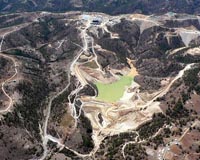| . |  |
. |
Washington (AFP) April 22, 2010 A study of tree rings provided Thursday the most detailed record yet of at least four epic droughts that hit Asia over the past millennium, including one that helped end China's Ming Dynasty in 1644. Data collected over the past 15 years for the study is expected to help scientists understand how climate change can unleash large-scale weather disruptions. Any drastic shifts to the seasonal monsoon rains in Asia, which feed nearly half the world's population by helping crops grow, could have serious socio-economic consequences, according to scientists at Columbia University's Lamont-Doherty Earth Observatory. They mapped out past droughts and their relative severity by sampling the wood of thousands of ancient trees across Asia. Among them was a drought that caused tens of millions of people to starve to death in the late 1870s. "Global climate models fail to accurately simulate the Asian monsoon, and these limitations have hampered our ability to plan for future, potentially rapid and heretofore unexpected shifts in a warming world," said lead author Edward Cook, head of Lamont's Tree Ring Lab. Prior to the study, published in Friday's edition of Science, reliable instrumental data collected in Asia -- such as temperature, rain accumulations and winds -- only dated back to 1950. The scientists pointed to some evidence that monsoon changes are driven at least in part by variations in sea-surface temperatures, with some speculation but no certainty that warming global temperatures could modify and possibly intensify these cycles. The tree-ring records suggested that climate may have played an important roll in the fall of China's Ming dynasty in 1644, by providing additional evidence of a severe drought already referenced in some historical Chinese texts as the worst in five centuries at the time. According to the study, the drought occurred at some point between 1638 and 1641, most severely in northeastern China close to Beijing. It is believed to have helped fuel rebellions by farmers that eventually contributed to the Ming dynasty's fall. Southern China is currently experiencing its worst drought in nearly a century. Rainfall determines the width of the annual growth rings of some tree species. The researchers' trek across Asia to find trees old enough for long-term records took them to over 300 sites, to Siberia, Indonesia, northern Australia, Pakistan and as far east as Japan. "It's everything from lowland rainforests to high in the Himalayas," said study coauthor Kevin Anchukaitis, a Lamont tree ring scientist. "You have a tremendous diversity of environment, climate influences and species." University of Hawaii meteorologist Bin Wang said the tree-ring atlas is valuable to monsoon forecasters, allowing them to detect short-term and long-term patterns thanks to the detailed spatial areas and the length of the record.
Share This Article With Planet Earth
Related Links Climate Science News - Modeling, Mitigation Adaptation
 UN urges relief funds for Guatemala drought
UN urges relief funds for Guatemala droughtGeneva (AFP) April 9, 2010 The United Nations on Friday appealed for funds to help Guatemala cope with the worst drought in 30 years and counter a looming famine, after a March appeal for financing went largely unanswered. "This appeal of 4.7 million (dollars), which is not enormous, has received only three percent of financing... not even a million dollars," said Elisabeth Byrs, spokeswoman of the Office for the Coor ... read more |
|
| The content herein, unless otherwise known to be public domain, are Copyright 1995-2010 - SpaceDaily. AFP and UPI Wire Stories are copyright Agence France-Presse and United Press International. ESA Portal Reports are copyright European Space Agency. All NASA sourced material is public domain. Additional copyrights may apply in whole or part to other bona fide parties. Advertising does not imply endorsement,agreement or approval of any opinions, statements or information provided by SpaceDaily on any Web page published or hosted by SpaceDaily. Privacy Statement |